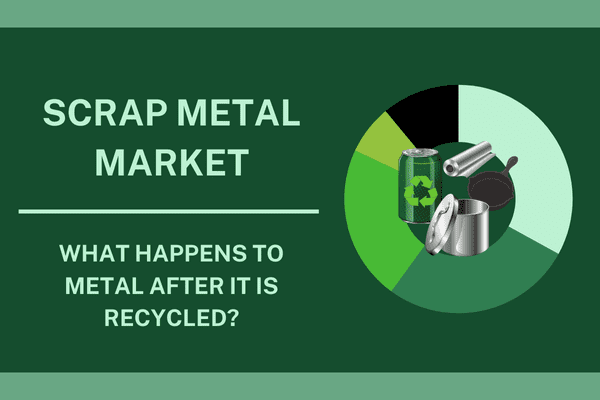
There are many benefits of going green for businesses, such as tax credits for going green. There’s a reason why going green by recycling is growing in industries. So what are the great reasons for businesses to go green?
Beyond just the public relations value of a business showing interest in the environment, there’s a host of additional benefits. That includes having a healthier workforce to cost savings to meeting the growing demand from consumers who want to spend their dollars at environmentally-friendly companies.
Going green can be a no-brainer for businesses today.
The bigger question may be the best way to contribute to the environment. And one of the most significant contributions that any business, large or small, can make is by the recycling of their scrap. It’s a proven method for creating a significantly healthier and cleaner environment for all of us.
Recycling in general is a smart idea. And it’s important to keep scrap metal from piling up in a community landfill, since these metals contain toxins like mercury and lead. Because that poses contamination risks to the soil, water and air. And it endangers nearby wildlife and people.
And the businesses making a commitment to scrap recycling are the ones that are going to prove they’ve successfully “gone green.”
Why Should a Business Consider Going Green?
Going green isn’t a short-term trend or the latest fad. Municipal governments, large corporations and a lot of other organizations have been carefully developing strong pro-environmental policies for years. And it’s been paying off for them.
There are tax credits for going green. Businesses going green offers considerable tax advantages. As states like California pass laws to reduce emissions, businesses need to comply. But there are numerous tax credit incentives at the state level to encourage them to do so.
In Florida, businesses get a sales tax exemption if they use solar energy systems, equipment and machinery. Likewise, the federal government provides businesses with a tax credit of up to 30 percent for using solar and wind energy.
There are also federal tax credits available to companies that use electric or hybrid automobiles and trucks as their fleet vehicles.
Businesses have tried going green in other ways. Some companies use green, environmentally-friendly cleaning supplies. Because that’s helped create a healthier workplace and improved conditions for workers with respiratory problems.
The Green Business Bureau notes that businesses promoting a healthier workplace can demonstrate a decline in the number of sick days used by employees. And they can show a reduction in the amount of money paid out in medical benefits.
And going green can be a great selling point and effective way to connect with a public supportive of environmental protections.
There are certainly consumers who like to know they’re doing business with companies that respect the environment. As a result, some companies make a point of emphasizing they’re a green business in their marketing efforts. Businesses also like to donate money to causes and organizations working to protect the environment.
So it’s no wonder that a growing number of companies are eagerly looking for ways to go green. This is not only a very positive public service, but also good for their bottom line.
And that’s an important reason why one of the most environmentally friendly policies they can adopt is to start recycling their scrap.
How do companies benefit from scrap recycling?
Scrap metals can be recycled and reused. That helps reduce business costs along the way. In fact, the U.S. recycles 150 million metric tons of scrap materials every year. That includes:
- 85 million tons of iron and steel
- 5.5 million tons of aluminum
- 1.8 million tons of copper
- 2 million tons of stainless steel
- 1.2 million tons of lead
- and 420,000 tons of zinc.
There are plenty of other metals, including brass, tin, bronze, chrome and magnesium, that also get recycled annually.
There are significant long-term costs savings to using recycled materials rather than the more costly option. And that’s mining metal ores and having them refined into usable metals.
This isn’t even a sustainable process, since the amount of metals present on earth is fixed. And recycling requires considerably less energy and water than mining for ore does.
Where are recycled metals used?

Today, recycled materials are used for industrial manufacturing not just in the U.S., but around the world. The U.S. exports billions worth of aluminum, copper, iron and steel.
A rising percentage of the steel used to produce car doors and hoods, for example, comes from recycled metals.
And it’s been estimated that nearly half of the copper used in home construction for plumbing pipes or electric wires is from recycled metals.
For businesses, arranging to collect their scrap metal items and bringing them to a recycling firm like GLE Scrap Metal is a smart business practice.
For example, businesses know they can trim operating costs by a host of small measures, from turning off lights in vacant offices to printing less and using more electronic forms instead. Companies that develop policies to reduce energy consumption contribute to helping the environment, while also saving money through lower energy bills.
Recycling is another great way to help the environment, while also helping the company earn money for their scrap metal. There are so many different scrap metal items that a company could turn in, including copper tubing, stainless steel equipment and furniture, auto parts, brass radiators, circuit breakers and wire scrap, among many others.
How does scrap metal contribute to savings?
Recycling metals offers great savings to all of us when it comes to energy, and preserving our natural resources.
There are, for example, far fewer amounts of greenhouse gas emissions produced during the recycling process than when metals must be made from virgin ore.
Metal recycling also helps us conserve our natural resources, particularly since water is used in large amounts when metals are manufactured from ore.
It’s also been estimated that recycling steel alone saves enough energy to power 18 million homes for a year.
It also reduces the depletion of our raw materials and natural resources, and the energy savings from recycling helps reduce CO2 emissions.
Go Green by Recycling Your Scrap
Today, in a time when many businesses simply can’t afford not to go green, recycling their scrap is a great way to get onboard. It’s a proven way to help our environment. It also produces enormous energy savings, and preserves our natural resources.
Best of all, a recycling firm like GLE Scrap Metal offers highly competitive rates for scrap from businesses.
GLE, a premier scrap metal and electronics recycler, performs environmentally-friendly processing and recycling of all base and precious metals. The metals they purchase are processed as recyclable base metals.
GLE is a family-owned and operated company. We supply domestic mills and global end-users with raw commodities that can be transformed into new products. It’s a great contribution to our environment.
Call GLE Scrap metal today at 855-SCRAP-88 to request a quote.


